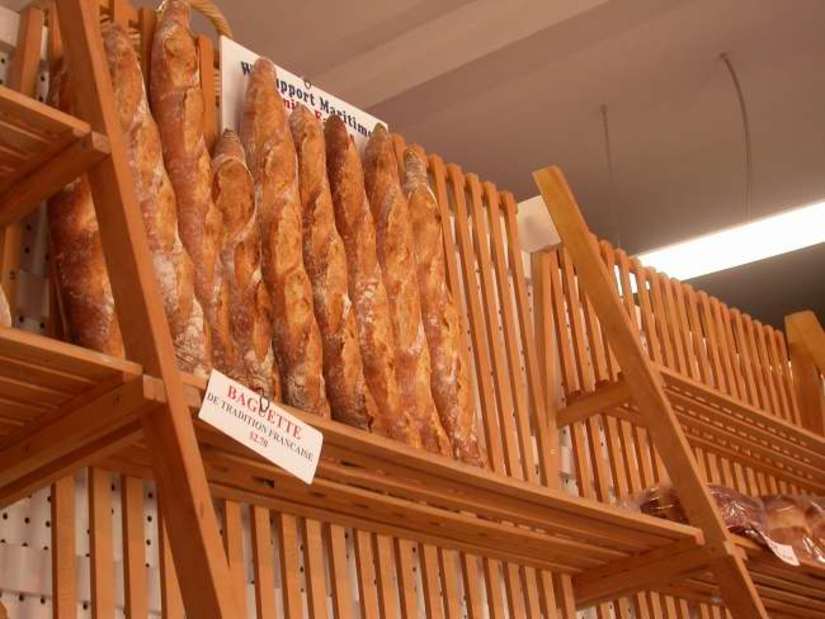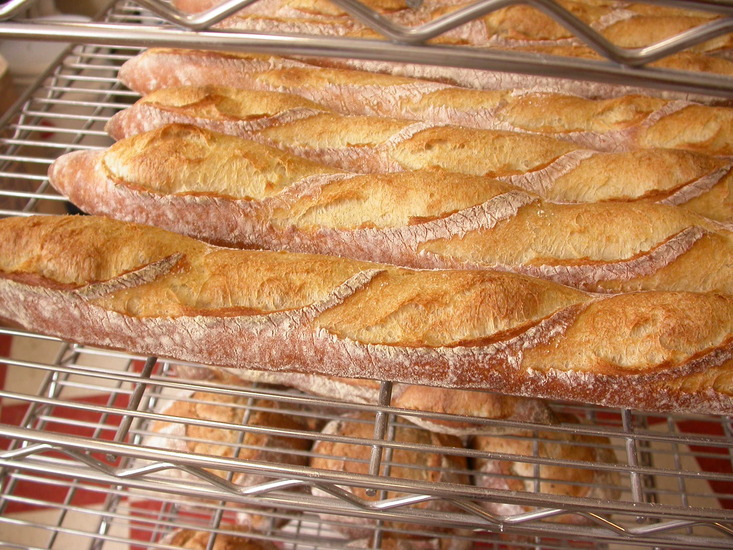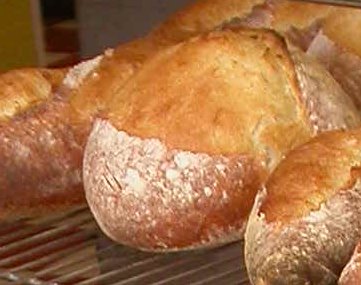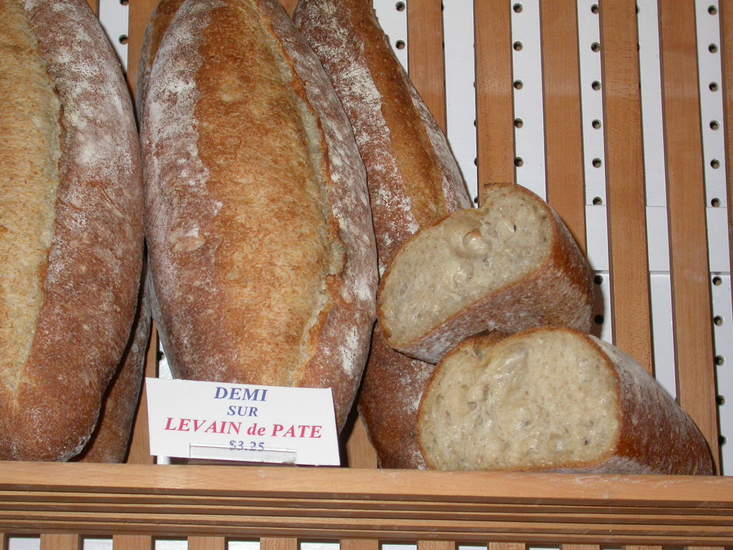
This is the Page,
Pain de tradition française
Edited 29 March 2016
Home
Bakery Benchmarks
Our Breads Nos pains
Bread Images
About Us
Our Equipment
Site map
Sources - Digital
Sources - Printed
Le public ignore généralement que le pain, comme le fromage ou le vin, représante un patrimoine considérable, diversifié en d'innombrables variétés régionales. Le boulanger français lui-même par nature est peu enclin au traditionalisme.
Lionel Poilâne, Guide de l'amateur de pain, 1981, 159
.
J'adore le pain français. Je souligne français parce que je suis américain, et que le pain dans mon pays est généralement immonde (Steven Kaplan, Cherchez le pain, 2004, 9.
Well-made bread
"strengtheth the stomach and carries truly with it the staff of nourishment."
Thomas Moffat, Health's
Improvement, (1595?, published 1655)
''Eat food, not too much, mostly plants.'' Michael Pollan, Food Rules (2009).
Pain de tradition française
Edited 29 March 2016
Home
Bakery Benchmarks
Our Breads Nos pains
Bread Images
About Us
Our Equipment
Site map
Sources - Digital
Sources - Printed
Le public ignore généralement que le pain, comme le fromage ou le vin, représante un patrimoine considérable, diversifié en d'innombrables variétés régionales. Le boulanger français lui-même par nature est peu enclin au traditionalisme.
Lionel Poilâne, Guide de l'amateur de pain, 1981, 159
.
J'adore le pain français. Je souligne français parce que je suis américain, et que le pain dans mon pays est généralement immonde (Steven Kaplan, Cherchez le pain, 2004, 9.
Well-made bread
"strengtheth the stomach and carries truly with it the staff of nourishment."
Thomas Moffat, Health's
Improvement, (1595?, published 1655)
''Eat food, not too much, mostly plants.'' Michael Pollan, Food Rules (2009).
NORTH
HEAD BAKERY
Hearth Breads, Craft, and Community
Hearth Breads, Craft, and Community
PAIN DE TRADITION FRANÇAISE
According to the décret du 1 septembre 1993 de la
République Française
any bread in France pretending to be traditionally French had to meet
these conditions: no freezing whatsoever in the course of its
elaboration; to contain no additives (excepting 2% bean flour, 0.5%
soya flour and 0.3% malt flour); to be composed exclusively of a
mixture of baking (panifiable)
flours,
potable water, and kitchen
salt; and to be fermented with baker's yeast (saccharomyces
cerevisiae)
and/or
levain.
Article four allowed the addition of a tiny amount of yeast in the last
kneading phase, 0.2% by weight of flour.
Of course, the French writ does not extend to Grand Manan. We have used the appellation, or at least the spirit of it, to the extent of using only unbleached and or organic flours, no bean nor soya flours and occasionally, when the enzymatic qualitities of the organic white flours appeared to droop, we have added malt flour, in less than the stipulated 0.3%. Our salt for most of the period since 1993 has been sel de Guérande, and we have employed fresh yeast, with only rare exceptions when either our yeast supply ran out, was shorted by our suppliers, or arrived in unusable states.
Under the heading of pains de tradition françaises, we make three breads daily, baguettes, boules, and demis , in two separate doughs. The larger breads are made with a dough that is fermented in bulk overnight, with divisionn, shaping, final proof
and bake early the following morning, while the baguettes are made en
directe,
usually the first dough mixed and kneaded in the day, around 05h00.
Both doughs feature an autolyse
of
15 to 30 minutes, slow mixing, in cooler weather, a bassinage at
the end of kneading of 5-10%, and a détente of about 30 minutes
before shaping. Division and shaping is manual, as it is for all breads
in the bakery, and proofing is sur
couche. (Photo of baguettes,
10 May 2007, by Richard Rice)
final proof
and bake early the following morning, while the baguettes are made en
directe,
usually the first dough mixed and kneaded in the day, around 05h00.
Both doughs feature an autolyse
of
15 to 30 minutes, slow mixing, in cooler weather, a bassinage at
the end of kneading of 5-10%, and a détente of about 30 minutes
before shaping. Division and shaping is manual, as it is for all breads
in the bakery, and proofing is sur
couche. (Photo of baguettes,
10 May 2007, by Richard Rice)
Of course, the French writ does not extend to Grand Manan. We have used the appellation, or at least the spirit of it, to the extent of using only unbleached and or organic flours, no bean nor soya flours and occasionally, when the enzymatic qualitities of the organic white flours appeared to droop, we have added malt flour, in less than the stipulated 0.3%. Our salt for most of the period since 1993 has been sel de Guérande, and we have employed fresh yeast, with only rare exceptions when either our yeast supply ran out, was shorted by our suppliers, or arrived in unusable states.
Under the heading of pains de tradition françaises, we make three breads daily, baguettes, boules, and demis , in two separate doughs. The larger breads are made with a dough that is fermented in bulk overnight, with divisionn, shaping,
 final proof
and bake early the following morning, while the baguettes are made en
directe,
usually the first dough mixed and kneaded in the day, around 05h00.
Both doughs feature an autolyse
of
15 to 30 minutes, slow mixing, in cooler weather, a bassinage at
the end of kneading of 5-10%, and a détente of about 30 minutes
before shaping. Division and shaping is manual, as it is for all breads
in the bakery, and proofing is sur
couche. (Photo of baguettes,
10 May 2007, by Richard Rice)
final proof
and bake early the following morning, while the baguettes are made en
directe,
usually the first dough mixed and kneaded in the day, around 05h00.
Both doughs feature an autolyse
of
15 to 30 minutes, slow mixing, in cooler weather, a bassinage at
the end of kneading of 5-10%, and a détente of about 30 minutes
before shaping. Division and shaping is manual, as it is for all breads
in the bakery, and proofing is sur
couche. (Photo of baguettes,
10 May 2007, by Richard Rice)BAGUETTES (Photo by Richard Rice, 3 October 2007)

BOULE
(photo by
Richard
Rice, 3 October 2007)
 The boules and demis
are both 'cut' at the same dough weight (500g), shaped, proofed and
baked together. The different shapes, hence their names,
result in breads with slightly different characteristics, mainly a
relatively softer crumb and crust for the boules.
Essentially,
the difference is rooted in the relative thickness and smaller surface
area of the
boule.
Not surprisingly, customers often have decided preferences. And, it
should bepointed out, a baker in French is a faiseur
de pain en boules, un boulanger.
The boules and demis
are both 'cut' at the same dough weight (500g), shaped, proofed and
baked together. The different shapes, hence their names,
result in breads with slightly different characteristics, mainly a
relatively softer crumb and crust for the boules.
Essentially,
the difference is rooted in the relative thickness and smaller surface
area of the
boule.
Not surprisingly, customers often have decided preferences. And, it
should bepointed out, a baker in French is a faiseur
de pain en boules, un boulanger.DEMI (photo by
Richard Rice)

The
demis above were made 16 September 2004, with the addition of a
prefermented dough, in this case liquid sourdough, following the method
as outlined in Patrick Castagna and Eric Keysar, Pain, evolution et tradition,''Le pain au levain de pâte'', 16-7,1994. Photo Richard Rice
DEMIS (made at home by the baker, 11 April 2010)
© 2016 North Head Bakery, 199 Route 776, Grand Manan, NB, E5G 1A4 506-662-8862